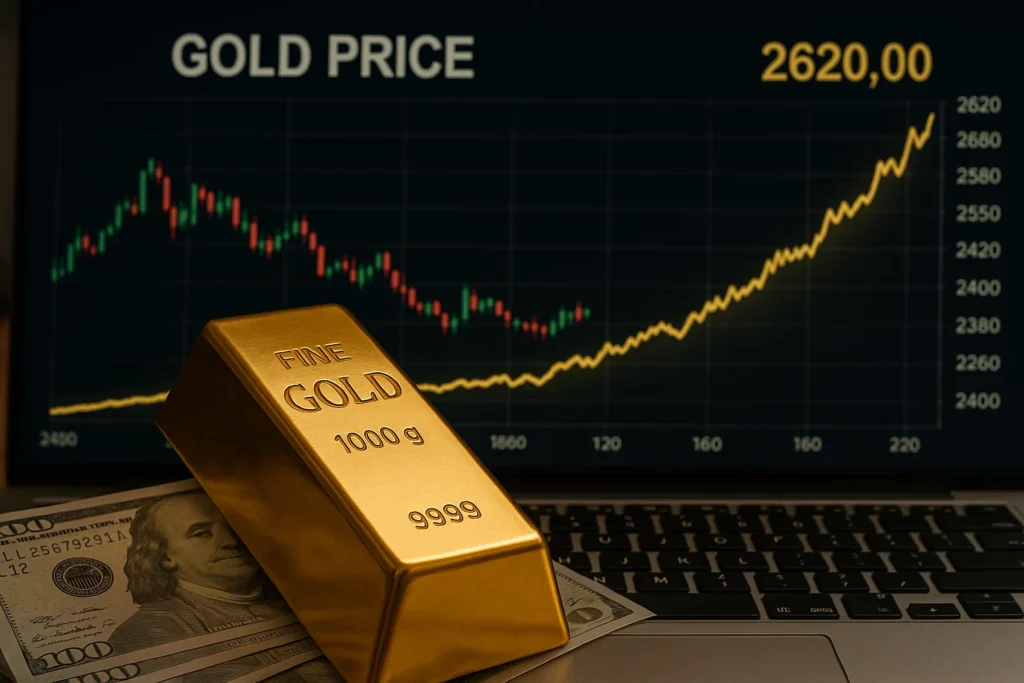Part I: The Grand Unraveling – A Retreat from Modern Finance
In a world increasingly defined by digital abstraction, where trillions of dollars can be conjured with a keystroke and markets are traded at the speed of light, humanity is making a dramatic return to a tangible, timeless anchor: gold. The metal’s surge to an unprecedented $2,620 per ounce is not a mere market fluctuation; it is a global signal flare, a collective cry of alarm from a financial system pushed to its breaking point. This historic moment represents a profound retreat from the promises of modern fiat currency and a return to first principles of wealth preservation. The grand, decades-long experiment with unbacked paper money is beginning to show its fundamental cracks, and gold, with its immutable history and physical presence, is once again asserting its role as the ultimate store of value.
The Limits of the Fiat Currency Experiment
The genesis of our current financial predicament lies in a pivotal moment in history: the end of the Bretton Woods system in the early 1970s. For a quarter-century, the U.S. dollar was pegged to gold, and other currencies were pegged to the dollar, providing a semblance of stability. When President Richard Nixon unilaterally ended the dollar’s convertibility to gold, the world entered the era of fiat currency—money whose value is based solely on government decree and public trust. This system was meant to give central banks flexibility to manage their economies, but it also unlocked the power of unlimited money creation.
Over the past two decades, this power has been wielded with abandon. In response to the 2008 financial crisis and the 2020 pandemic, central banks embarked on a spree of quantitative easing (QE), buying trillions of dollars in government bonds and other assets. This unprecedented expansion of central bank balance sheets, while preventing economic collapse, has had an insidious long-term effect: it has diluted the value of every existing unit of currency. It has also fueled what some economists call financial repression, where low interest rates punish savers and retirees, while asset prices for stocks and real estate soar, widening the wealth gap and fostering social and political instability. The gold price, in this context, is simply a reflection of this loss of purchasing power.
The Triffin Dilemma and the Faltering Pillars of Global Finance
The U.S. dollar’s role as the world’s reserve currency is a double-edged sword, a phenomenon known as the Triffin Dilemma. . To act as the world’s currency, the U.S. must run a persistent trade deficit, flooding the global economy with dollars to facilitate trade and investment. However, this very act of printing and exporting dollars erodes their value and undermines the world’s confidence in the currency over the long term. This inherent contradiction is now coming to a head, and its effects are visible in the faltering pillars of global finance.
- The U.S. Dollar’s Erosion: The U.S. national debt is now a staggering burden, with servicing costs consuming an ever-growing portion of the federal budget. This fiscal unsustainability, combined with political paralysis, has cast a long shadow over the dollar’s credibility. Furthermore, the use of the dollar as a geopolitical weapon through sanctions has accelerated a global movement to de-dollarize. Major trading blocs are now actively exploring alternative payment systems and currencies for bilateral trade, a direct challenge to the dollar’s “exorbitant privilege.”
- The Euro’s Existential Crisis: The Eurozone’s fundamental design flaw—a single currency without a unified fiscal policy—is creating massive economic stress. The European Central Bank struggles to set a single interest rate that fits both Germany’s industrial juggernaut and the heavily indebted economies of Southern Europe. This has led to dangerous economic imbalances and continuous political friction, making the euro a less-than-ideal safe haven.
- The Japanese Yen’s Demographic Time Bomb: Japan’s economy has been in a state of arrested development for over three decades, battling deflation and a rapidly aging population. The Bank of Japan has resorted to extreme monetary policies, including negative interest rates and “yield curve control,” to stimulate growth. However, this has created an untenable situation of colossal public debt and a currency that offers little protection against global shocks. The yen’s weakness is a stark reminder that monetary policy alone cannot solve deep-seated economic and demographic problems.
The Sovereign Shift: Central Banks’ Strategic Preparation
The most powerful endorsement of gold’s value comes not from speculative investors but from the world’s central banks. For years, these institutions have been on an unprecedented gold-buying spree, with nations like China, Russia, and India leading the charge. This isn’t a passive investment; it’s a strategic, geopolitical repositioning. These countries are preparing for a multipolar world where the U.S. dollar is no longer the sole arbiter of global finance. Gold, as a neutral, non-sovereign asset, serves as the perfect foundation for this new financial architecture. It is a form of national wealth that cannot be sanctioned, frozen, or devalued by any other nation, providing a level of monetary sovereignty that is becoming increasingly critical in a fragmented world.
Part II: The Perfect Storm – Forces Driving the Gold Rush
While the systemic crisis of fiat currency provides the motive, a confluence of other powerful forces is amplifying gold’s appeal and pushing its price to record highs.
1. Geopolitical Fragmentation and the End of Globalization
The era of a seamless, interconnected global village is over. The world is witnessing a rapid uncoupling of economies, supply chains, and political interests. This phenomenon, often termed “deglobalization,” is a move away from efficiency toward resilience. Nations and corporations are re-evaluating their dependencies, leading to protectionist policies, trade wars, and the fragmentation of global commerce into competing blocs. . In this environment, trust is in short supply. Gold, as a universal currency that transcends national borders and political allegiances, becomes the ultimate panic button for investors seeking refuge from a fractured world.
2. The Inflation Conundrum: A Multi-Front Battle
Inflation is no longer a simple issue of “too much money chasing too few goods.” Today’s inflation is a complex beast with three heads:
- Monetary Inflation: The result of over a decade of reckless money printing.
- Cost-Push Inflation: Driven by persistent supply chain disruptions and rising energy costs, which push up the price of goods.
- Demand-Pull Inflation: Caused by massive post-pandemic stimulus packages that injected a wave of consumer spending into the economy.
Gold is a powerful hedge against all three. Its value is not a promise but a function of its rarity and the immense energy and labor required to extract it from the earth. As the purchasing power of paper money continues to erode, gold’s value rises in real terms, making it an essential defense against the “silent tax” of inflation.
3. Escaping Systemic Volatility and the “Everything Bubble”
For years, historically low interest rates encouraged massive speculation, creating a bubble in a wide range of assets from technology stocks to real estate. Many “zombie companies” were kept alive by cheap credit, masking the true fragility of the economy. The current market volatility, marked by wild swings and a sense of profound uncertainty, is the direct consequence of this over-leveraged system beginning to unwind. Gold, with its proven history of being an inverse-correlator to equities during times of crisis, provides a much-needed ballast. It offers stability when other investments are failing and serves as an indispensable portfolio diversifier.
4. The Digital Gold Rush: The Modern Investor’s Embrace
The current rally is not solely driven by traditional investors. The advent of technology has democratized access to gold through Exchange-Traded Funds (ETFs), allowing even small-scale investors to own a piece of the bullion market. This new wave of demand, fueled by younger investors disillusioned with the volatility of cryptocurrencies and the risks of meme stocks, is a significant tailwind for the market. While Bitcoin is often touted as “digital gold,” its short history and immense volatility make it a poor substitute for the millennia-long track record and physical permanence of gold.
Part III: The Global Ripple Effect – Winners, Losers, and Consequences
Gold’s historic rally is more than just a market story; it is a global economic event with clear and profound consequences.
The Winners: The Golden Harvest
- Gold Mining Companies: For producers like Barrick Gold and Newmont Corporation, the surge in prices is a massive windfall. The cost of mining an ounce of gold remains relatively stable, so every dollar increase in the market price directly translates to a boost in profit margins. This new capital is being used to fund exploration, develop new mines, and increase dividends, creating a powerful and sustained feedback loop for the entire industry.
- Sovereign Nations and Prudent Investors: Countries with large gold reserves, like Switzerland and Germany, see the value of their national assets increase, providing a solid foundation for their economies. Similarly, institutional and individual investors who had the foresight to hold gold are now reaping substantial rewards, having successfully insulated their wealth from the erosion of fiat currencies.
The Losers: The Cost of Disconnection
- Gold-Importing Nations: For countries like India and Turkey, where gold plays a critical role in cultural traditions and family savings, the high price is a severe economic headwind. The cost of gold imports widens their trade deficits, weakening their national currencies and fueling domestic inflation. This puts immense financial pressure on millions of families who now find it nearly impossible to save in their preferred asset.
- The Average Consumer: The high price of gold impacts more than just jewelry. It affects a wide range of industries, from electronics to dentistry. The average person is also left in a difficult position, feeling locked out of a traditional form of wealth preservation while their savings in bank accounts and low-yield bonds lose value to inflation.
Part IV: The Path Forward – A New Financial Paradigm
The crucial question remains: is this rally sustainable? The answer lies not in a short-term forecast but in a long-term analysis of systemic trends.
The Bullish Case: A New Paradigm Emerges
The forces driving gold’s rise are not cyclical; they are structural.
- Inescapable Debt: Global debt levels are at an all-time high, making it nearly impossible for central banks to raise interest rates to a level that would truly combat inflation without triggering a severe recession. This suggests that a return to monetary easing is almost inevitable.
- Continued Geopolitical Fragmentation: The shift toward a multipolar world is not a passing fad. The erosion of trust and the rise of economic nationalism will continue to favor a neutral, un-seizable asset like gold.
- Persistent Inflation: The blend of monetary and cost-push factors suggests that inflation will remain a persistent problem, continuing to drive demand for a reliable hedge.
The Bearish Case: Potential Headwinds
No market moves in a straight line. Potential headwinds for gold could include a swift and unexpected end to a major geopolitical conflict, or a coordinated, successful effort by central banks to defeat inflation without a recession. A massive technological breakthrough that dramatically lowers the cost of gold mining could also increase supply and temper prices. However, these scenarios seem unlikely to fully reverse the fundamental shift in investor psychology.
Gold as a Systemic Indicator
Ultimately, the gold price is the market’s loudest and clearest indicator of the health of the global financial system. Its value isn’t just about supply and demand; it’s a reflection of our collective confidence in the future of paper money and the stability of the global order. When gold rises, it is a signal that our trust in that system is eroding.
Conclusion: A Return to First Principles
In a world filled with abstract promises and digital currencies, gold stands as a physical constant—a form of wealth that cannot be printed into existence or erased by a hack. Its recent, historic rise is a testament to its timeless role as the ultimate safe haven. The world’s current flight to gold is a powerful repudiation of a financial system that has become over-leveraged, debt-ridden, and fragile. It is a return to first principles, a powerful reminder that true value is found not in a government’s promise, but in a metal that has proven its worth for millennia. As the global financial system navigates a period of profound change, gold has once again emerged as the essential anchor, providing security and stability in an increasingly uncertain world.



